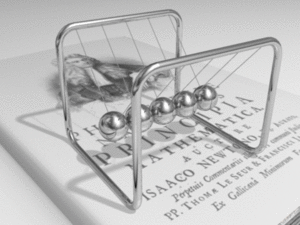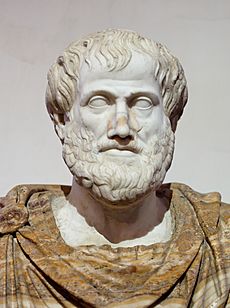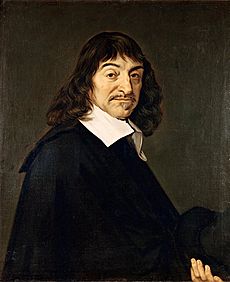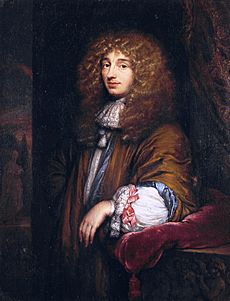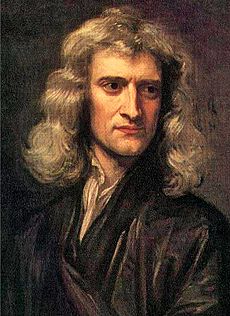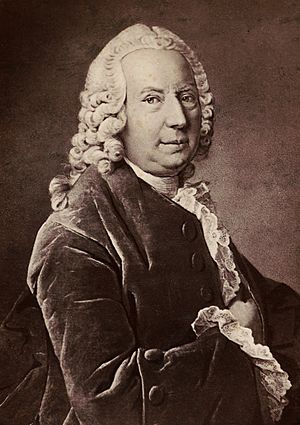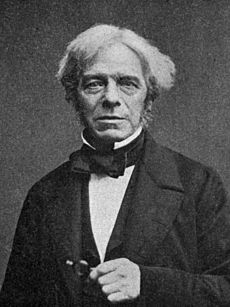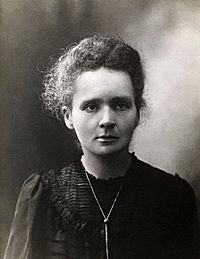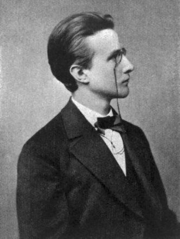History of physics facts for kids
Physics is a branch of science that studies matter and energy. It helps us understand how the world works. Discoveries in physics are used in all other natural sciences and in technology. Today, physics is often split into classical physics (older ideas) and modern physics (newer ideas).
Contents
- Early Ideas About Physics
- The Scientific Revolution
- 18th Century: Developing Mechanics and Heat
- 19th Century: Electromagnetism and Energy
- 20th Century: Modern Physics Begins
- Modern Physics and the Universe
- Images for kids
- See also
Early Ideas About Physics
Long ago, people started studying the world around them. Early ideas that became physics came from astronomy (study of stars), optics (study of light), and mechanics (study of motion). These ideas were often linked to geometry.
Greek Thinkers and Nature
The ancient Greeks were among the first to try to understand nature using reason. This began around 650-480 BCE.
Thales and Natural Causes
Thales of Miletus (7th and 6th centuries BCE) is sometimes called "the Father of Science." He believed that every event had a natural cause, not a supernatural one. Thales thought water was the basic element of everything. He also experimented with magnets and rubbed amber.
Aristotle's View of Motion
Aristotle (384–322 BCE) was a famous Greek philosopher. He believed that observing nature could help us find its laws. Aristotle wrote the first book called "Physics." He tried to explain motion and gravity using the idea of four elements: earth, water, air, and fire. He thought things moved to their "natural place." For example, a stone falls to the ground because earth tends to go downwards. Aristotle's ideas were very popular for many centuries.
Earth's Shape and Orbit
People in ancient Greece knew the Earth was round. Around 240 BCE, Eratosthenes (276–194 BCE) accurately measured its size.
Aristarchus of Samos (c. 310 – c. 230 BCE) suggested that the Sun, not the Earth, was at the center of our Solar System. This idea is called heliocentrism. Seleucus of Seleucia later supported this, saying the Earth spins on its axis and orbits the Sun.
Archimedes and Buoyancy

Archimedes of Syracuse (287–212 BCE) was a brilliant Greek mathematician. He laid the groundwork for understanding how liquids behave (hydrostatics) and how things balance (statics). He also figured out the math behind the lever. Archimedes developed the law of buoyancy, known as Archimedes' principle. This explains why objects float or sink in water.
Physics in India and China
Important ideas about physics also came from ancient China and India.
Early Atomic Ideas
In India, Maharishi Kanada developed a theory of atomism around 200 BCE. He thought that the smallest particle of matter, called "Parmanu," could not be divided further. These atoms were believed to be indestructible.
Magnetism and Optics
In China, the study of magnetism goes back to the 4th century BCE. Shen Kuo (1031–1095) was a Chinese scientist who described the magnetic compass for navigation. He also developed a camera obscura, which is a basic camera.
Physics in the Islamic World
From the 7th to 15th centuries, science made great progress in the Muslim world. Many ancient Greek and Indian works were translated into Arabic.
Ibn al-Haytham and Light
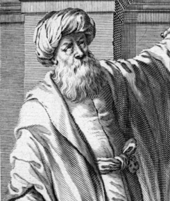
Ibn al-Haytham (965–1040) was an Arab scientist who founded modern optics. He suggested that light travels to the eye from objects in rays. This was different from earlier ideas that light shone from the eye. Ibn al-Haytham used experiments to test his ideas about light.
Ibn Sina and Motion
Ibn Sīnā (980–1037) was a Persian scientist who made important contributions to physics and medicine. He had a theory of motion that was similar to Newton's first law of motion. He believed that an object would keep moving unless something stopped it. This was different from Aristotle's idea that objects needed a continuous push to stay in motion.
The Scientific Revolution
The 16th and 17th centuries saw a huge leap in science in Europe. This period is called the Scientific Revolution. Scientists began to challenge old ideas and use mathematics to describe how things move.
Nicolaus Copernicus and the Sun-Centered System
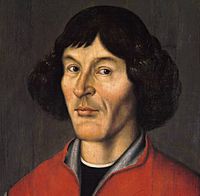
Nicolaus Copernicus (1473–1543) was a Polish astronomer. In 1543, he strongly argued for a heliocentric model of the Solar System. This means the Earth and other planets orbit the Sun. This idea was revolutionary because for over 1,400 years, people believed the Earth was the center of the universe. Copernicus's work marked the start of modern astronomy.
Galileo Galilei: Experiment and Observation
Galileo Galilei (1564–1642) was an Italian mathematician, astronomer, and physicist. He supported Copernicus's ideas and improved the telescope. Galileo believed that experiments were key to understanding nature.
Galileo's Discoveries
Galileo studied how things fall. He found that objects do not fall faster just because they are heavier. He also discovered that the path of a thrown object is a parabola. His ideas helped set the stage for Newton's laws of motion.
Using his telescope, Galileo made amazing discoveries. He saw the phases of Venus, like the phases of our Moon. He also discovered Jupiter's four largest moons. These moons are now called the "Galilean moons." His discoveries showed that not everything revolved around Earth.
Galileo is often called the "father of modern physics" and the "father of science." However, his support for the Sun-centered model got him into trouble with the church. He was forced to deny his beliefs and spent his last years under house arrest.
René Descartes and Universal Principles
René Descartes (1596–1650) was a French philosopher. He wanted to replace old ideas with a new system. Descartes thought that all physical events could be explained by the motion of tiny particles. He believed that different types of motion, like planets moving or objects falling, were all part of the same universal rules. Descartes also helped develop analytical geometry, which connects algebra and geometry.
Christiaan Huygens: Waves and Clocks
Christiaan Huygens (1629–1695) was a Dutch physicist and mathematician. He was a leading scientist between Galileo and Newton. Huygens invented the pendulum clock, which was the most accurate timekeeper for nearly 300 years. His work on pendulums led to his important book, Horologium Oscillatorium.
Huygens also developed a wave theory of light. He believed light traveled in waves, not tiny particles. This idea was later confirmed. As an astronomer, he was the first to correctly describe the rings of Saturn and discovered its moon, Titan.
Isaac Newton: Laws of Motion and Gravity
Sir Isaac Newton (1642-1727) was an English physicist and mathematician. He brought together earlier discoveries to create a single system for understanding the universe.
Newton's Key Ideas
Newton developed three laws of motion that explain how objects move. He also formulated the law of universal gravitation. This law explains why objects fall to Earth and why planets orbit the Sun. To do this, Newton invented calculus, a new branch of mathematics. His book, Philosophiæ Naturalis Principia Mathematica (1687), marked the start of modern mechanics and astronomy.
Newton showed that the same laws govern objects on Earth and in space. He proved that the motions of any object could be predicted mathematically if you knew its current motion, mass, and the forces acting on it. Newton also built the first working reflecting telescope and developed a theory of color based on how a prism splits white light into a rainbow.
Other Important Discoveries
Many other scientists made important contributions during this time. William Gilbert studied magnetism and showed that Earth acts like a giant magnet. Robert Boyle studied gases and created Boyle's law, which describes how gas pressure and volume are related.
Early Ideas About Heat and Engines
Otto von Guericke designed the first vacuum pump in 1650. This helped scientists study vacuums and air pressure. Later, Denis Papin developed the idea of a piston and cylinder engine. Based on his designs, Thomas Savery built the first steam engine in 1697. These early engines were not very efficient, but they showed the potential of converting heat into useful work.
18th Century: Developing Mechanics and Heat
In the 18th century, scientists continued to build on Newton's ideas. They used calculus to solve more complex problems of motion.
Advances in Mechanics
Daniel Bernoulli (1700–1782) made important studies of gases, which helped lead to the kinetic theory of gases. He also studied how fluids flow, described in his work Hydrodynamica.
Scientists like Leonhard Euler and Joseph Louis Lagrange further developed the mathematics of motion. In 1789, Antoine Lavoisier stated the law of conservation of mass, meaning matter cannot be created or destroyed.
Understanding Heat and Electricity
In the 18th century, heat was often thought of as a fluid called "caloric." Even though this idea was later proven wrong, it led to important discoveries. Scientists like Joseph Black studied latent heat, which is the heat absorbed or released during a change of state.
Benjamin Franklin showed that lightning is a form of electricity in 1752. He described electricity as a fluid flowing between areas of excess and deficit. This led to the idea of positive and negative charges.
19th Century: Electromagnetism and Energy
The 19th century brought major breakthroughs in understanding electricity, magnetism, and energy.
Electromagnetism: Light and Power
In 1800, Alessandro Volta invented the voltaic pile, the first electric battery. This made it easier to study electric currents. Thomas Young showed that light behaves like a wave in 1801.
In 1820, Hans Christian Ørsted discovered that electric currents create magnetic forces. A year later, Michael Faraday built the first electric motor. In 1831, Faraday discovered electromagnetic induction, showing that magnetism can produce electricity. These discoveries are the basis for electric motors and generators.
James Clerk Maxwell (1831–1879) brought together the ideas of electricity, magnetism, and light. In 1864, he published his theory that light is an electromagnetic phenomenon. This meant light is a wave of electric and magnetic fields. His work was a huge triumph for physics.
Laws of Thermodynamics

(1824–1907)
Scientists like James Prescott Joule showed that heat is a form of energy in the 1840s. This led to the first law of thermodynamics, which states that energy cannot be created or destroyed. Lord Kelvin and Rudolf Clausius helped formulate this law around 1850.
Kelvin and Clausius also stated the second law of thermodynamics. This law explains that heat naturally flows from hotter objects to colder ones, and that systems tend to become more disordered (a concept called entropy).
Statistical Mechanics
Ludwig Boltzmann (1844–1906) and Josiah Willard Gibbs (1839–1903) developed statistical mechanics. This new approach uses statistics to understand how large numbers of tiny particles behave. It helped explain the laws of thermodynamics by looking at the probabilities of different arrangements of molecules.
Other Discoveries
In 1822, Robert Brown observed Brownian motion. This is the jiggling movement of tiny particles in a fluid, caused by collisions with invisible atoms or molecules. In 1842, Christian Doppler proposed the Doppler effect, which explains how the frequency of a wave changes if the source or observer is moving.
20th Century: Modern Physics Begins
By the end of the 19th century, many physicists thought all major laws of physics had been found. But around 1900, new problems arose that classical physics could not explain. This led to a major revolution and the birth of modern physics.
Radiation and the Atom
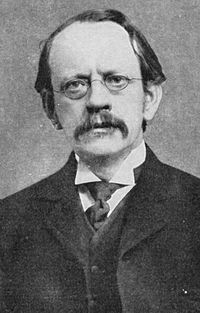
In 1895, Wilhelm Röntgen discovered X-rays. In 1896, Henri Becquerel found that some materials emit radiation on their own. In 1897, J. J. Thomson discovered the electron, a tiny particle smaller than an atom.
Marie and Pierre Curie discovered new radioactive elements like radium and polonium. They called this property "radioactivity." Ernest Rutherford later showed that atoms have a tiny, dense, positively charged center called a nucleus, surrounded by electrons.
Albert Einstein's Theory of Relativity

In 1905, Albert Einstein (1879–1955) introduced his groundbreaking theory of relativity. This theory changed how we understand space and time.
Special Relativity
Einstein's special relativity states that the speed of light in a vacuum is always the same for all observers, no matter how they are moving. It also showed that measurements of time and length can change depending on how an observer is moving. For objects moving very fast, close to the speed of light, clocks slow down and lengths shorten. Einstein also developed the famous equation: E = mc2, which shows that mass and energy are equivalent.
General Relativity

In 1916, Einstein expanded his theory to include gravitation, creating the general theory of relativity. This theory explains gravity as the bending of space-time caused by mass and energy. It predicts that light can bend around massive objects, and it led to the idea of black holes.
Quantum Mechanics
Another big problem for classical physics was explaining blackbody radiation and the photoelectric effect. This led to the development of quantum mechanics, the theory of atoms and subatomic particles.
Quanta and Atomic Models
The basic idea of quantum theory was introduced in 1900 by Max Planck (1858–1947). He proposed that energy is emitted and absorbed in tiny, discrete packets called "quanta."
In 1913, Niels Bohr used quantum ideas to explain the stability of Rutherford's atom model and how atoms emit light. This led to a full-scale quantum mechanics in the 1920s.
Key figures like Werner Heisenberg and Erwin Schrödinger developed quantum mechanics further. Heisenberg's 1927 "uncertainty principle" states that you cannot precisely know both the position and momentum of a particle at the same time. Quantum mechanics became essential for understanding the atomic world.
Modern Physics and the Universe
Modern physics continues to explore the smallest particles and the largest structures in the universe.
Quantum Field Theory
Scientists developed quantum field theory to combine quantum mechanics with special relativity. This led to quantum electrodynamics (QED), which describes how light and matter interact.
New theories also explained how forces are transmitted between particles through "virtual particles." For example, Hideki Yukawa proposed a particle called the "pion" that holds the nucleus together.
The Standard Model

The Standard Model is a major achievement in physics. It successfully describes three of the four fundamental forces of nature: the strong interaction, weak interaction, and electromagnetic interaction. It also classifies all known elementary particles.
The Standard Model was developed by many scientists, including Abdus Salam, Steven Weinberg, and Sheldon Glashow, who unified the electromagnetic and weak forces.
Cosmology: The Universe's Story
Cosmology is the study of the universe as a whole. Einstein's general relativity helped make cosmology a serious field.
Big Bang Theory
In the 1920s, Hubble and Slipher discovered that the universe is expanding. This led to the Big Bang theory, which suggests the universe began from a very hot, dense state. The discovery of Cosmic background radiation in the 1960s strongly supported the Big Bang theory.
Dark Matter and Dark Energy
More recently, observations have shown new mysteries. Scientists believe there is "dark matter" that helps galaxies hold together, and "dark energy" that is speeding up the expansion of the universe. We can't see these, but their effects are observed.
The Higgs Boson
On July 4, 2012, physicists at CERN's Large Hadron Collider announced the discovery of a new subatomic particle. This particle strongly resembles the Higgs boson. The Higgs boson is a key part of the Standard Model. It helps explain why elementary particles have mass. This discovery was a huge moment for particle physics. Peter Higgs was one of the scientists who first proposed the idea of the Higgs field in 1964.
Images for kids
-
Star maps by the 11th-century Chinese polymath Su Song are the oldest known woodblock-printed star maps to have survived to the present day.
-
A page from al-Khwārizmī's Algebra.
-
Gottfried Leibniz
(1646–1716) -
James Clerk Maxwell
(1831–1879) -
Ludwig Boltzmann
(1844-1906) -
A Feynman diagram representing (left to right) the production of a photon (blue sine wave) from the annihilation of an electron and its complementary antiparticle, the positron. The photon becomes a quark–antiquark pair and a gluon (green spiral) is released.
-
Richard Feynman's Los Alamos ID badge
See also
 In Spanish: Historia de la física para niños
In Spanish: Historia de la física para niños
- History of optics
- History of electrical engineering
- History of electromagnetism
- History of measurement
- List of physicists
- Nobel Prize in physics
- List of Nobel laureates in Physics
- Timeline of fundamental physics discoveries


